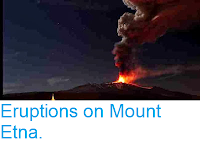The Etna Observatory of the Istituto Nazionale di Geofisica e Vulcanologia has reported an eruption from a newly opened fissure on the southeast flank of Mount Etna, Sicily, on Monday 24 December 2018, the first time such a fissure has opened on the volcano in over a decade. The eruption occurred at about noon. local time, and was preceded by about 300 small tremors, which are often indicative of magma moving into new chambers beneath a volcano, followed by ash and lava eruptions from the new fissure, with lava flows visible on the flanks of the volcano. There are no reports of any damage or casualties associated with this event, but several local communities reported ashfalls, hikers were kept off higher parts of the mountain, and Catania Airport was temporarily closed due to high dangers of volcanic ash.
Volcanic ash is extremely hazardous to aircraft in a number of ways. At its most obvious it is opaque, both visually and to radar. Then it is abrasive, ash particles physically scour aircraft, damaging components and frosting windows. However the ash is most dangerous when it is sucked into jet engines, here the high temperatures can melt the tiny silica particles, forming volcanic glass which then clogs engine. When this happens the only hope the aircraft has is to dive sharply, in the hope that cold air passing through the engine during the descent will cause the glass to shatter, allowing the engine to be restarted.
Etna first erupted about half a million years ago, beneath the sea off the east coast of Sicily, and has been going strong ever since. It now stands 3330 m above sea level, and covers 1200 km³. It is responsible for fertile soils across eastern Sicily. Records of eruptions on Etna go back to 1500 BC. It is Europe's second largest volcano, after Teide in the Canary Islands, and is one of the most active volcanoes in the world.
Volcanic ash is extremely hazardous to aircraft in a number of ways. At its most obvious it is opaque, both visually and to radar. Then it is abrasive, ash particles physically scour aircraft, damaging components and frosting windows. However the ash is most dangerous when it is sucked into jet engines, here the high temperatures can melt the tiny silica particles, forming volcanic glass which then clogs engine. When this happens the only hope the aircraft has is to dive sharply, in the hope that cold air passing through the engine during the descent will cause the glass to shatter, allowing the engine to be restarted.
Lava flow on the upper flank of Mount Etna on Monday 24 December 2018. Reuters.
Etna first erupted about half a million years ago, beneath the sea off the east coast of Sicily, and has been going strong ever since. It now stands 3330 m above sea level, and covers 1200 km³. It is responsible for fertile soils across eastern Sicily. Records of eruptions on Etna go back to 1500 BC. It is Europe's second largest volcano, after Teide in the Canary Islands, and is one of the most active volcanoes in the world.
Ash column over Mount Etna on 24 December 2018. Giovani Isolino/AFP.
Despite all this Etna has only ever caused 77 recorded deaths (the most recent being two tourists caught in a summit explosion in 1987) and relatively little destruction. In 1928 it destroyed the village of Mascali on its northeastern flank, though there were no reported casualties, the village being slowly overrun by a lava flow. In 1669 a much larger lava flow destroyed at least 10 villages, reaching the walls of the city of Catania, 40 km to the south, but again without loss of life. In 122 BC a heavy ash fall covered much of the region, causing several buildings to collapse in Catania. The destruction was deemed so severe by the Roman authorities that they granted the city a 10 year tax holiday. In about 6000 BC a landslide on the eastern flank of the volcano is thought to have caused a tsunami that caused destruction around much of the eastern Mediterranean.
The location of Mount Etna. Google Maps.
Etna is located on the border of the African and European Plates, specifically where Africa is being subducted beneath the European Plate. As it is drawn into the Earth's interior material from the African Plate melts, and the lighter portions rise up through the overlying European Plate, causing a number of volcanoes including Etna and Vesuvius.
Map showing the tectonic plates underlying Italy and southern Europe, and the location of the l'Aquila Earthquake. Napoli Unplugged.
See also...
Follow Sciency Thoughts on Facebook.











